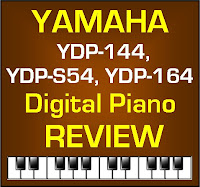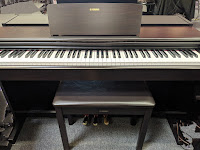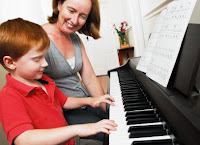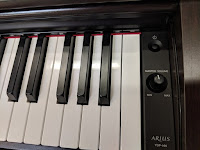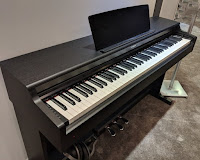UPDATED REVIEW | Jan 1, 2022 -| REVIEW & Comparison | Yamaha YDP-144, YDP-164, and YDP-S54 Arius digital pianos | For many years Yamaha has had a popular line of digital pianos called the Arius series which are generally priced somewhere between $1000 to $2000. These pianos have been fairly consistent in their piano sound, key action, pedaling and features over the years with more subtle changes being found in later models rather than large changes.
May 1, 2022 UPDATE: The Yamaha Arius digital pianos in this review have now been replaced by the new 2022 YDP-145 at $1299, YDP-S55 at $1599, and YDP-165 at $1`799. The previous and now discontinued models YDP-144 ($1199 price), YDP-S54 ($1449 price), and the YDP-164 ($1599 price) may still be offered for sale in a few places, but the new ones are now the current models and have also gone up in price. The new models are nearly identical to the older ones including the key actions with the exceptions of a more realistic piano sound engine on the new models, the back of the cabinet (YDP-145/165) have sound projection ports in them, and a couple of other things.
The first and most important thing to discuss on these Arius digital pianos in my opinion is the key actions. As with all pianos, whether they be digital or acoustic, it’s the way the keys move up & down that is the center of attention as far as I am concerned as well as with most of my piano teacher friends. Having taught thousands of piano students over the years, I believe if the student does not have a good piano at home with a responsive, realistic key action then that student will likely build negative playing habits when practicing on their piano at home. When they are at a teacher’s studio that amount of time is generally about 30 minutes per week for a lesson. All the rest of the time the student is practicing on their piano (or keyboard) at home to try to recreate a good piano playing experience. Assuming the piano teacher has a good piano then that teacher hopes the piano student will also have a good piano at home to practice the lesson properly.
The key action in the YDP-144 is Yamaha’s “entry-level” key action called GHS. The GHS (graded hammer standard) has been around for many years and is also used in their lowest price P-45 portable digital piano ($549 price) all the way up to this YDP-144 piano. The feel of this piano “weighted” key action is relatively light as far as force needed to press down the keys (which is ok) but the keys also have a noticeably firm pressure coming up against the fingers when the keys are coming back up, especially when you press the keys all the way down and feel a harder force pressing back up against your fingers than you would feel on a real acoustic piano or in a
number of other digital pianos.
 This type of upward force is not at all what real acoustic key actions do and feel like and it’s something I don’t personally care for. It’s not that the GHS isn’t playable because it is…I just prefer to invest my money into a key action I can be happy with and use for years to comes as I grow in my skills, especially for a beginner student. The key action is graded (a bit heavier to a bit lighter key weight going up the keyboard left to right) and weighted as I just mentioned. The GHS action has 2 key sensors per key which are not “high definition” sensors as found in a couple of lower priced Casio models, but are standard sensors as have been in this GHS action for many years.
This type of upward force is not at all what real acoustic key actions do and feel like and it’s something I don’t personally care for. It’s not that the GHS isn’t playable because it is…I just prefer to invest my money into a key action I can be happy with and use for years to comes as I grow in my skills, especially for a beginner student. The key action is graded (a bit heavier to a bit lighter key weight going up the keyboard left to right) and weighted as I just mentioned. The GHS action has 2 key sensors per key which are not “high definition” sensors as found in a couple of lower priced Casio models, but are standard sensors as have been in this GHS action for many years. The key action in the YDP-S54 and YDP164 are identical and that key action is called GH3 (graded weighted hammer with 3 key sensors per key). This key action in these two models have a much heavier/firmer key action touch when pressing down the keys. The force it takes to get the keys to go down is much heavier in the GH3 key action as opposed tom the GHS and heavier/firmer than all of the competition and in my opinion that is not necessarily a good thing. Too much down-weight (touch weight) when your fingers are pressing down on the keys can create fatigue in the fingers, hands, and wrists especially for young children, older people, and those people with issues with finger movement. The other brands and models in this general price range such as Kawai, Korg, Casio, and

Roland have key actions with noticeably less down-weight and more like a real acoustic piano and as a piano teacher I much prefer it that way because the transition from from playing a digital piano to playing a real acoustic piano will be much better and more natural if the touch weight force that is needed from your fingers to press down the keys is less rather than more.

best upright digital piano called the NU1X ($6899) utilizing an actual upright piano key action, the static touch-weight/down-weight on that model measured on middle C is approx 55 grams of force….which is almost a perfect weight and just like a good Yamaha grand piano. However, on the Yamaha YDP-164 or YDPS54, the touch-weight/down-weight force needed measured on middle C is approx 85-90 grams of force required to press the key down. In other words, the Yamaha Arius pianos with the GH3 key actions are needing a lot more finger force to press down the keys as Yamaha’s best digital

upright piano NU1X based on my experience playing and measuring this pianos for key action. I am not saying you should spend $6000 on a piano to get a good key action!
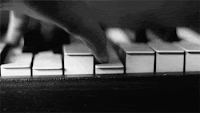
more comfortable to press down. However, there is another issue concerning keys that I have not talked about. The amount of key return force pushing your fingers back up is quite a bit and if you have keys that are pushing back on your fingers with too much force then that can also make your playing unnatural and even uncomfortable. So it is really the opposite from the other one in terms of key movement.
There are 3 key sensors per key in the GH3 key action (hence the “3” in the action model number) so that key action will have a better note repetition recognition than the GHS key action and this is a benefit to more intermediate to advanced players when they are able to play the keys faster and with more repetitive notes. The material used on the white and black keytops of the GH3 key action is a proprietary synthetic ivory material to try to replicate old ivory and ebony keys on traditional acoustic pianos that were available many decades ago but are no longer available now. Ivory (and ebony) was a good organic material to help absorb sweat from the fingers, it made the key tops smoother, and it cuts down on the plastic glare coming from shiny white and black plastic keytops on some other digital pianos.
The piano sound realism in these Arius digital pianos over the last many years has been disappointing to me because it just sounded artificial, compressed, not natural, lacked dynamic tonal range and expression, and had relative short sustain-decay time when using the sustain pedal. I have never been a big fan of the Yamaha acoustic piano sound simulation specifically in the Arius models. However, I am happy to announce that for the first time Yamaha now has what I consider to be a very big upgrade in terms of the organic nature and realism of the piano sound in these new models. Unlike previous Arius models and the current new ones where Yamaha is still using the same key actions as before, the Arius pianos YDP-144, YDP-S54, and YDP-164 have a completely new piano sound chip that takes care of all of these previous issues I had complained about in terms of the quality of the acoustic piano sound.
The piano pedals on all 3 models provide a relative good pedal playing experience for students and piano players by offering all 3 pedal functions including the damper-sustain pedal, the middle sostenuto pedal which few people use anymore (it’s really more decorative at this point), and the left soft pedal which reduces volume of the played notes instantly when using this pedal…some people do use that pedal depending on the complexity of the music. So when it comes to pedaling, all the pedals function well and are relatively robust and quiet. The damper-sustain pedal also triggers the half-damper effect which allows for a variable amount of sustain-decay time for the notes as opposed to a pedal that is only on & off as far as the sustain sound does, meaning that the sustain would otherwise be fully on or completely off and would not have a variable amount (lesser or a bit more) sustain time.
Overall the Yamaha Arius digital pianos are pretty basic in terms of what they can do. Each model has 10 instrument sounds including the main stereo CFX grand piano sound along with 2 additional piano sounds which include a mellow piano and also a bright piano. There is also 2 electric pianos, 1 harpsichord, 1 vibraphone, 2 organs including jazz and pipe organ, and 1 string symphony sound, The CFX piano sound is really the one to use most of the time because it it by far the most realistic of the 3 piano sounds. The other sounds are pretty good with some being more realistic than others, but the “naturally sustaining tones” don’t react to a “pedal sustain hold” that other digital piano brands have including Roland, Casio, Kawai, and Korg.
Other features in these 3 pianos include the ability to digitally transpose the key up or down which can be useful if you are playing in one key but want to hear it in another key or you want the song in your vocal range but the key the song is written in is not in your vocal range. You can layer/mix any two instrument/piano sounds together and add reverb-echo to the sound along with being able to control the overall tone of the sound with adding more “brilliance” or brightness to the sound and reducing the amount of that effect to make the piano sound more mellow overall.
The internal speaker system in these pianos make a big difference in the piano sound that you hear because you can have a great piano sound chip but if you don’t have a good internal speaker system to support that sound in a high fidelity way, then you might as well look for something else. With regard to the YDP-144, it has two 4.72″ speakers going through two 8 watt amplifiers (total 16 watts) using 9 watts of power, so it does have an efficient power usage. However, after trying this YDP-144 many times I noticed that there is not a lot of volume when the master volume control is set from 0 volume up to about 60% volume.
When it comes to internal speaker systems in digital pianos, it’s not only about the amount of speakers, speaker size, speaker quality, and audio power, but it’s also about how the speakers are positioned within the piano. The 2 speakers in the YDP-S54 and YDP-164 which are the same size as what are in the YDP-144 are built into the piano and positioned facing down to the floor within the inside bottom of the piano.
All of these models have 2 stereo headphone jacks and a USB connector to device such as computer, iPad, etc. There are no audio outputs, audio inputs, no Bluetooth wireless capability, no USB flashdrive input, etc. The USB/MIDI connector is a very necessary feature these days, especially given that Yamaha has a cool proprietary iOS “controller” app called Smart Pianist” which allows you to control the various functions in these pianos from the color touch screen on an iPad which is extremely helpful and much more intuitive than using the piano control panel which is not intuitive at all considering the things these pianos can do.
The furniture cabinets are fairly attractive with the YDP-144 and YDP-164 having the more traditional furniture type pedestal cabinets with slide out key covers and the YDP-S54 having a compact contemporary furniture cabinet with fold down key cover that is pretty cool because it folds down flat and gives the entire piano top a nice flat surface when closed up. The YDP164 has a more traditional look of a real piano along with a bit more height on it than does the YDP144 so it just looks more elegant and sturdy. The music holder racks on the 144 and 164 are traditional in design and support sheet music in the proper position along with built in music clips to hold the music in place whereas the YDPS54 has a fold down sheet music support in the middle of the key cover.
If you want more info on new digital pianos and LOWER PRICES than internet discounts, please email me at tim@azpianowholesale.com or call direct at 602-571-1864.




